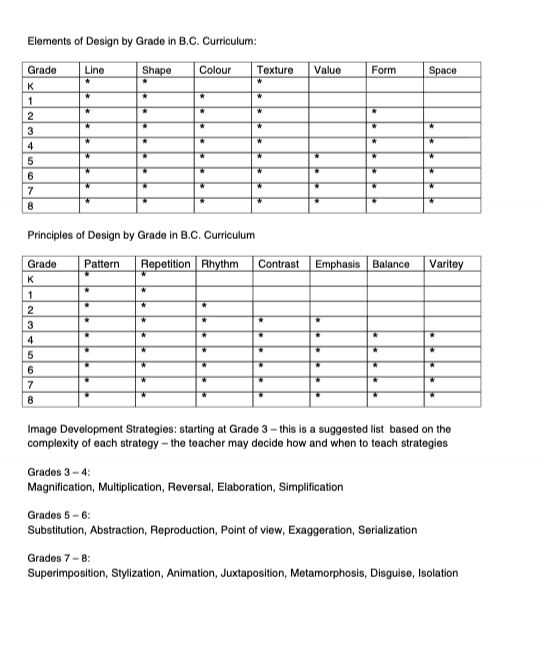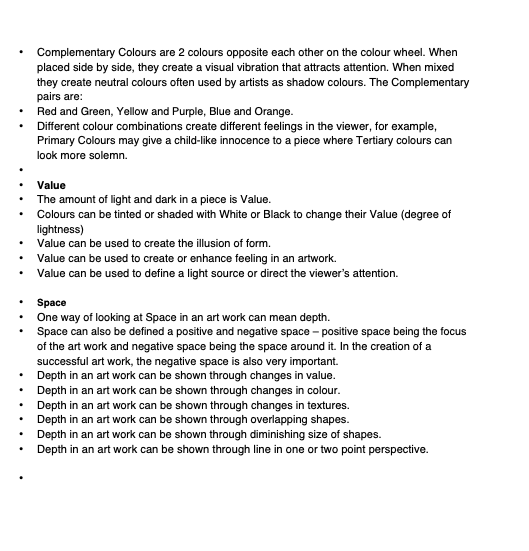Here are all the resources that can help with unit planning in my future are classroom!
Planning throughout the year:
When you are planning art throughout the year, focus on planning your units with these tips in mind:
- Teach a unit on one aspect of each Element of Design (approximately 1 month in 1 art class per week). Integrate with other subjects when it works. Plan to teach all of these (that are appropriate for the grade level) each year.
- Add 2 image development strategies to appropriate element units per year.
- Add 2 principles of design per year to appropriate elements of design units per year.
This chart is really helpful to consider what elements of design/ principles of design/ image development strategies should be introduced by each grade level:

Another helpful tool is this list that explains the aspects of each element of design. The points at the top of each category are introduced in younger grades, whereas the points towards the bottom are introduced to older students.


Unit Planning
Unit planning is great strategy to plan art classes. Here are some advantages of planning in units as opposed to one-off lessons:
- Research shows that we all learn better with context. Having a single focus for a month of art lessons allows the teacher to build context better.
- The B.C. curriculum supports integration of different subjects to increase learning in all subjects. It is much easier to create successful integration between subject units when unit planning.
- Working with a topic over time allows the teacher to do relaxed formative assessments for learning rather than focusing on summative assessment of learning.
- Unit planning is the best use of teacher planning time, as planning is spread over an entire month.
*Information from EDCI 307A Powerpoint 2 on Brightspace – Kathleen Schmalz.
Here are the different parts of a unit plan:

Discovery: Provides a hands-on opportunity for students to explore with the element of design/ principle of design/ image development strategy.
Consolidation: Write out a critical analysis (keep in mind the Big Idea and First Peoples Principles of your unit when creating your questions). You can also include a practice activity in this step, where students have another opportunity for hands on practice. This can be in the form of whole class practice or through short activities at centres.
Inquiry: This step allows students to use their own knowledge and understanding through an open-minded exploration of a meaningful question. Word this inquiry in a format like this: “Can you use the materials from the Discovery to create an artwork that utilizes the [Image Development Strategy] and [Element of Design] to show… [use concept from your Big Idea and/or Indigenous Principle].”
Reflection: Plan how your students will reflect on their work. This could be an informal exhibition with verbal explanation, written questions, a powerpoint, a portfolio checklist, etc.
Assessment: Go back through your unit and plan how you will assess each activity. The formative assessment should be fluid and not take away from experimentation (i.e., non-judgemental critiques). There should also always be some form of summative assessment at the end of the unit so you have data for report cards.
Content Expectations: What the students will learn
Curriculum Competencies: How they will use and show what they have learned
*Information from EDCI 307A Powerpoint 8 and 9 from Brightspace – Kathleen Schmalz
Here is a unit planning template that can help when planning an art unit!
Leave a Reply
You must be logged in to post a comment.